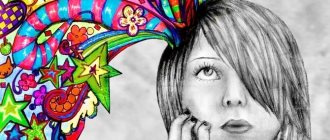Hypnopompic hallucinations are strange visions that occur upon awakening.
Imagine that you are slowly waking up, when suddenly you begin to see bright geometric shapes, hear sounds, or even feel someone's touch. These sensations can be described as hypnopompic, since you are not completely asleep, but at the same time are not yet fully awake. Although hypnopompic phenomena are often observed among patients with various types of sleep disorders (eg, narcolepsy), they are also observed in healthy people (about 6.6% of the world's population).
In some cases, these hypnopompic hallucinations can be frightening and accompanied by an episode of sleep paralysis. In other cases, they may be relatively benign (such as geometric shapes) or even pleasant (such as the feeling of floating or flying).
The experience of hypnopompic hallucinations is often the result of individual brain anatomy, neurochemistry, or accumulated subconscious experience. They differ from dreams in that they are perceived as happening in reality. []
Kinds
- True. The patient sees, feels or hears something, but this phenomenon is bright, living in nature. The hallucination is real for the sufferer.
- Pseudohallucinations. These are visions, sounds or sensations that occur outside of objective reality.
Important: false hallucinations usually depend on suggestion or the influence of external factors.
Hallucinations vary depending on the specific sense organs that perceive:
- Visual. These can be entire storylines, mystical visions, just flashes of light or smoke. And also animals, identical objects, vision of organs in one’s body or foreign objects, etc.
- Auditory. These include ordinary noises or sounds, as well as verbal ones: imperative, when a certain voice orders the patient to do something, usually it is negative; commenting - voices discuss the patient’s thoughts, feelings and sensations, they are also negative and judgmental; contrasting, when the patient hears 2 voices directed against each other, one condemns the patient, the other defends, but at the same time they give conflicting commands to the sufferer; speech motor - it seems to the patient that certain forces are speaking for him, in an unknown language.
- Olfactory. The patient complains of unpleasant odors.
- Flavoring. The patient may experience unpleasant tastes in the mouth.
- Tactile: sensation of liquid, different temperatures, insects crawling, hugging.
- Functional. Against the background of any objects or phenomena, imaginary images, sounds, etc. appear.
- Hallucinations of Bonnet. The imaginary sensation is perceived by the analyzer that has completely or partially lost its function.
- Hemianoptic. Occurs due to a disease called hemianopsia. This is when the patient sees only half of the field of vision. Imaginary sensations arise in the area that does not see.
- Hypnagogic and hypnopompic hallucinations. They can occur even in a healthy person. They appear in the form of imaginary images or sounds that accompany a person when waking up or falling asleep. They are connected with the events of the day experienced.
Types of hallucinations depending on the analyzer:
- Psychomotor, when the patient feels that part of his body is in motion.
- Reflex, when, with a real impact on one analyzer, another is excited.
- Ecstatic. Vivid pictures or entire images appear in a state of altered consciousness.
Important: hallucinations must be distinguished from mirages and illusions, because they arise based on other factors.
Diagnosis
Diagnosing hallucinations is difficult because they are experienced very subjectively. A psychiatrist assesses the patient’s mental state and the presence of pathologies, looking at the picture of the disease.
Diagnostic procedures will be as follows:
- Clinical survey;
- Observation;
- Provocative tests.
Clinical survey
In the process of communicating with the patient, the doctor must identify delusional syndrome. Patients may respond adequately to direct questions, but themselves report events in their lives that are implausible. This could be a story about reading thoughts or suggestion with a glance, etc. The doctor can also interview family members to obtain a more accurate clinical picture.
Observation
The nature of the hallucinations can be shown by the patient’s actions and his emotional state. He can stare into space, experiencing different emotions. With hallucinations associated with hearing, the patient will listen, talk to someone, swear or laugh. Due to the occurrence of tactile sensations, the patient scratches, rubs the skin, and feels imaginary insects.
Provocative tests
Taking tests that reveal hidden disorders in perception:
- Aschaffenburg test: a person speaks on a switched off telephone, the presence of hallucinations is assumed when starting a conversation, hearing sounds from the receiver;
- Reichardt's test: a person looks at a blank piece of paper, if he sees something on it, then it is a hallucination;
- Lipman's test: if a person sees images when pressing on the eyelid, then this is also an indicator of hallucinations.
Causes
Misleading images, sounds, or sensations may occur when:
- Dementia. It seems to the patient that objects are moving.
- Parkinson's disease. Visual images appear: people, animals, objects, or even entire situations.
- Migraine. Patients see flickering or colored zigzag lines in the central region of the visual field. They leave behind a white spot that disappears after half an hour.
- Epilepsy. Visual images, in the form of bright spots or outlines.
- Sleep disturbance. Usually occur when waking up or falling asleep.
- Brain stem infarction. Bright and colorful scenes appear. They usually carry a semantic load. They can last from 1 minute to several hours.
- A brain tumor. Hallucinations can be of different types. This depends on the localization of the pathological process.
- Creutzfeldt-Jakob disease. It occurs due to prion infection and causes dystrophic processes in the cerebral and spinal cord, basal ganglia. Visual hallucinations occur: color changes, perception in reduced sizes, distortion of object characteristics, etc.
- Sclerosis of cerebral vessels. Auditory and visual hallucinations appear.
- Stroke.
In addition to the reasons described above, the culprits of hallucinations may be: Aging.
- Infectious diseases.
- Pathologies of internal organs.
- Intoxication with medications.
- Poisoning with toxic substances.
Phases of withdrawal syndrome
In the later stages of the manifestation of withdrawal syndrome, it is necessary to provide the person with drug treatment: otherwise, a breakdown or serious deterioration in well-being may occur.
Initial withdrawal
Begins 8 hours after the last drink. There is anxiety, nausea, pain in the gastrointestinal tract, sleep disturbances and appetite. Accompanied by tachycardia or hypertension.
Average degree
It begins 2-3 days after abstaining from alcohol. Consciousness becomes confused, hypertension, tachycardia, and sleep disturbances occur.
Severe withdrawal
After 2-4 days, signs of delirium tremens develop: hallucinations, seizures, fever, irritability. After binge drinking, alcoholic psychosis is possible.
Which doctor should I contact?
Hallucination is not a separate disease, but a symptom that occurs when a particular organ is damaged, in most cases the brain. But in order to identify the real cause of the pathology, you need to consult the following specialists:
- Psychiatrist.
- Neurologist.
- Oncologist.
- Expert in narcology.
- Infectious disease specialist.
Hallucinations are an important symptom that indicates that the patient has certain disturbances in awareness of the surrounding reality. Patients are often embarrassed or afraid to talk about the presence of hallucinations, because they think that only people with mental disorders experience hallucinatory experiences.
IMPORTANT! This is a false, persistent belief; different specialists need to work with hallucinations. The fact is that hallucinations can occur due to the presence of a neoplasm or infectious pathology.
Therefore, make an appointment with a specialist from our center - a psychiatrist, neurologist, oncologist, narcologist or infectious disease specialist to find the root of the problem and eliminate the symptom!
Sign up
Why do they arise?
When they talk about visions before going to bed, this is not a pathology. They are classified as pseudohallucinations. After all, any person can have them. Teenagers and young adults are especially susceptible to them. In adults they appear against the background:
- alcohol intoxication;
- taking drugs or toxic substances;
- prolonged insomnia;
- migraine attacks;
- anxious and stressful situations.
Patients with schizophrenia and epilepsy are susceptible to hypnagogic states
Hallucinations are associated with irritation of the reticular formation of the midbrain. Constant visions while falling asleep may occur in those who have tumors of the third ventricle and cerebral peduncles. Lesions occur in this area due to hemorrhages resulting from trauma or stroke. The inflammatory-infectious nature of the appearance of hypnagogic hallucinations cannot be ruled out.
When children experience various emotional experiences or nervous strains, they develop illusions that they can tell adults about. These are people's voices and real and fantastic images. To prevent the development of pathologies in a child, it is necessary to show him to a specialist.
Treatment methods
Treatment methods for pathology depend on the causes that caused it. There is no single scheme. For example, in case of poisoning with toxic substances, you need to stop their effect on the body. If there are neurological causes, it is necessary to begin appropriate therapy or stop the acute form of the disease.
Treatment is usually carried out with:
- Neuroleptics.
- Antidepressants.
- Means to improve blood circulation in the brain.
- Antiparkinsonian drugs.
Ghost of pain
Phantom pain and phantom limbs
For the first time phantom pain
- pain in amputated or paralyzed limbs - was described by the American doctor Silas Ware Mitchell.
During the American Civil War, he cared for wounded soldiers and observed this strange effect in almost everyone who suffered an amputation. Mitchell also recorded a similar paradox - the sensation of the presence of a remote part of the body, not associated with pain. The doctor called these distortions of perception phantom limbs
.
The medical journal Pain in 2000 cited statistics according to which patients feel a lost limb or pain, burning, tingling, itching, and sometimes even cramps not only immediately after amputation, but also for a long time after - 65% of respondents confirmed that they experienced these phantom sensations six months after the removal of a body part.
Some time ago this phenomenon was considered solved. Doctors believed that phantom pain was caused by traumatic neuromas—abnormally overgrown nerve fibers in the area of a severed limb that grew into the connective tissue of the scar, became irritated even with light touches, and sent signals of pain to the brain. However, everything turned out to be not so simple. In 1998, the Oxford journal Brain published a review of studies showing that phantom pain can be experienced by people with congenital absence of limbs. This called into question the universality of the version about traumatic neuromas.
Scientists began to look for reasons in the functioning of the central nervous system. Research using magnetic resonance imaging has led to the conclusion that areas of the brain that regulate the perception of the shape and image of one's body may be responsible for the sensation of phantom limbs and pain.
Lifestyle during hallucinations
The patient’s further life depends on the reasons that caused the pathology. If there is a disease that cannot be treated, then you need to constantly maintain normal functioning with the help of medications. If hallucinations were caused by certain diseases, then after getting rid of them you need to engage in further prevention.
Important: you should also give up bad habits, lead a healthy lifestyle, and strengthen your immune system.
If hallucinations occur, you should consider going to the doctor. Especially if the pathology is protracted. The symptom may indicate deep brain damage. If you make a diagnosis in time and start treatment, you can get rid of intrusive images, sensations or sounds.
Remember what didn't happen
Pseudo-reminiscences, confabulations and cryptomnesia
Sometimes, when our memory is impaired or impaired, our brain creates false memories - this phenomenon is called paramnesia.
. It, like the phenomena described above, can be a symptom of mental disorders, but sometimes manifests itself in healthy people.
Psychiatrists divide false memories into three types: pseudoreminiscences
when events from the distant past are perceived by a person as having happened recently (ten years ago you were given an excellent popular science book, and you are absolutely sure that you received it as a gift for this New Year);
confabulations
- the replacement of some episodes of the past with fictitious or distorted memories (you remember that at school you had a pencil case in the shape of a rocket, but in fact it was not you who had such a pencil case, but your neighbor at your desk);
cryptomnesia
, when the source of specific information is forgotten and a person seems to perceive it for the first time (as a child, a line from Pushkin stuck in your soul, and several decades later you write a poem in which there is exactly the same line; at the same time, you are sure that we composed it ourselves).
The first researchers of paramnesia were Pierre Janet and Sigmund Freud. Moreover, Freud associated this phenomenon with traumatic experiences of the past (loss of loved ones, violence or other stressful situations), which the human psyche tries to repress and replace with distorted memories. However, modern research shows that such memory impairments can occur without serious preconditions. Exactly how these effects work is still a mystery.
Symptoms
Hypnagogic hallucinations are manifested by the development of non-existent events during sleep. Most often they bother patients during the period of falling asleep or the first hours of sleep.
The condition is characterized by:
- sense of smell;
- feeling of falling or being in a state of flight;
- sounds;
- visual images. Hypnagogic images are vivid and the patient clearly describes the object seen.
Unlike dreams, the patient can accurately describe hallucinations upon awakening and will perceive everything that happens as if it happened in reality.
Conscious hallucinations that appear systematically begin to bother the patient. These events are real in nature, which raises doubts among others.
Literature
- Petit, Dominique; Pennestri, Marie-Hélène; Paquet, Jean; Desautels, Alex; Zadra, Antonio et al. (2015) Childhood Sleepwalking and Sleep Terrors: A Longitudinal Study of Prevalence and Familial Aggregation // JAMA Pediatrics
- Littlewood DL et al. Nightmares and Suicide in Posttraumatic Stress Disorder: The Mediating Role of Defeat, Entrapment, and Hopelessness //Journal of clinical sleep medicine: JCSM: official publication of the American Academy of Sleep Medicine. — 2015.
- Arango, Maria-Teresa; Kivity, Shaye; Shoenfeld, Yehuda (2015) Is narcolepsy a classical autoimmune disease? // Pharmacological Research - vol. 92 - p. 6-12
- Dzodzomenyo S. et al. Urine toxicology screen in multiple sleep latency test: the correlation of positive tetrahydrocannabinol, drug negative patients, and narcolepsy //Journal of clinical sleep medicine: JCSM: official publication of the American Academy of Sleep Medicine. – 2015. – T. 11. – No. 2. – P. 93.








